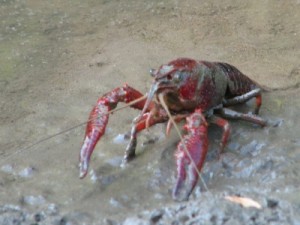Several areas of North America are experiencing drought conditions this summer which impacts freshwater fishing in several ways.
Shallow ponds may recede to a fraction of their size and some dry up entirely. While low water levels can be devastating to fish populations, in some cases the event may actually improve conditions as overpopulated ponds loose fish.
Low oxygen levels are a major threat but other factors combine to kill off fish. In some areas, fish and other small pond inhabitants become crowded in remaining deep areas. These conditions often allow herons and other predators to congregate and feed on large numbers of fish.
To deal with droughts and lack of oxygen, crayfish ( crawfish) venture up on the shoreline, sometime even migrating to other bodies of water. Others simply take a break along a pond’s edge and get a little fresh air. Once they are re-oxygenated, these crafty crustaceans march back and re-enter the water. Crayfish also build burrows along shorelines, hiding below until rain falls.
Pond owners often take advantage of these periods by cleaning up shorelines, removing trash and old lures and surveying fish populations.
Larger lakes are much less susceptible to droughts, but still see effects. Lake anglers often take advantage of these periods by surveying shorelines and other structure while water levels are low. This is an excellent way to gather detailed information about underwater geography.
